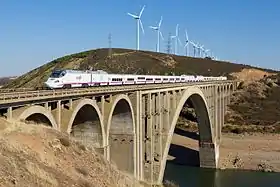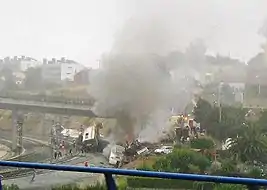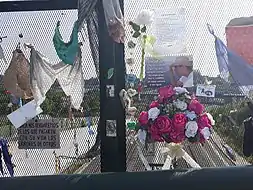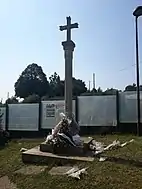Santiago de Compostela derailment
The Santiago de Compostela derailment occurred on 24 July 2013, when an Alvia high-speed train traveling from Madrid to Ferrol, in the north-west of Spain, derailed at high speed on a bend about 4 kilometres (2.5 mi) outside of the railway station at Santiago de Compostela. Out of 222 people (218 passengers and 4 crew) on board, around 140 were injured and 79 died.[2]
| Santiago de Compostela derailment | |
|---|---|
.jpg.webp) Rescue efforts on 24 July 2013 | |
| Details | |
| Date | 24 July 2013 20:41 CEST (UTC+02:00)[1] |
| Location | Angrois, Santiago de Compostela, Galicia, Spain 3.2 km (2.0 mi) SE from Santiago de Compostela |
| Coordinates | 42°51′34.2″N 8°31′40″W |
| Country | Spain |
| Line | Madrid–Ferrol |
| Operator | Renfe |
| Incident type | Derailment |
| Cause | Overspeed on curve |
| Statistics | |
| Trains | 1 |
| Passengers | 218[1] |
| Crew | 4 |
| Deaths | 79 |
| Injured | 139 |
| Damage | Eight carriages, one dining car, two generator cars, two locomotives |
The train's data recorder showed that it was traveling at about twice the posted speed limit of 80 kilometres per hour (50 mph) when it entered a bend in the rail. The crash was recorded on a track-side camera which shows all thirteen train cars derailing and four overturning. On 28 July 2013, the train's driver, Francisco José Garzón Amo, was charged with 79 counts of homicide by professional recklessness and an undetermined number of counts of causing injury by professional recklessness.[3]
The crash was Spain's worst rail accident in forty years, since a crash near El Cuervo, Seville, in 1972.[4][note 1] The Torre del Bierzo crash in 1944 remains the deadliest.
Background
Spain has one of the world's most extensive high-speed railway (HSR) networks, built and maintained by the state-owned infrastructure company Adif[5] and run by the operator Renfe, which is also a state-owned company[6] which manages the rolling stock.
The RENFE Class 730 passenger train is in service on this line, as it can run on both conventional and high-speed tracks.[7] The Class 730 also has two generator cars that allow its electric traction motors to function on non-electrified lines, but which bring its weight per axle well over the normal value for high velocity trains.[8] It is essentially a hybrid system, and is built up of pieces which had not been accredited as a whole. The train has a top speed of 180 kilometres per hour (110 mph) when running in diesel mode, and around 260 kilometres per hour (160 mph) when running on overhead electrification.
Derailment
At 20:41 CEST (18:41 UTC) on 24 July 2013,[1][9] the passenger train, on an express route from Madrid to Ferrol, derailed on a section of conventional track at the end of the Olmedo-Zamora-Galicia line, at Angrois in Santiago de Compostela.[10] All vehicles – the two power cars, their adjacent generator cars (both with diesel tanks) at both ends of the train and the nine intermediate carriages – derailed as the train rounded the A Grandeira curve; four cars overturned.[10] A track-side CCTV camera video indicates that the front generator car was the first to leave the rails, followed by the leading passenger coaches, the front power car, the rear generator car and finally the rear power car.[11][12] Three of the carriages were torn apart in the accident and another caught fire due to gaseous leaking diesel fuel. The rear generator car also caught fire.
The train was carrying 218 passengers at the time of the crash.[1] Out of the 218 passengers, there were 79 fatalities (at one point reported as 80 due to a misidentification of some body parts) and the remaining 139 were injured. Among the dead there were twelve foreigners: two French, two Italians, two Americans, an Algerian, a Venezuelan, a Brazilian, a Colombian, a Mexican and a Dominican.[13] One of the victims was Spanish journalist Enrique Beotas. The train's two drivers were injured but survived.[14][15]
Reaction
The regional government leader, Alberto Núñez Feijóo, remarked, "There are bodies lying on the railway track. It's a Dante-esque scene".[10] About 320 Spanish national police were dispatched to the scene of the accident. Festivities planned for 25 July, which is a regional holiday, were cancelled.[10]
Prime Minister Mariano Rajoy called an emergency ministerial meeting, saying, "I want to express my affection and solidarity with the victims of the terrible train accident in Santiago."[16] On 25 July, Rajoy visited the area and declared three days of national mourning.[10] King Juan Carlos and Queen Sofía visited injured survivors in hospital at Santiago de Compostela.[17][18]
On 9 August, the Spanish government announced that there would be a nationwide review of all railway lines, their signalling and the route knowledge of train drivers.[19]
Investigation
The Comisión de Investigación de Accidentes Ferroviarios is responsible for the investigation of railway accidents in Spain. A government spokesperson said that all signs pointed to the Santiago de Compostela derailment being an accident and said there was no evidence that terrorism was a factor.[7] Sabotage was also ruled out.
Eyewitnesses said the train was travelling at high speed before derailing.[9][20][21] This was confirmed by data from the train's black box which revealed that 250 m (820 ft) before the start of the curve the train was travelling at 195 km/h (121 mph), and in spite of the emergency brakes being applied was still travelling at 179 km/h (111 mph) when it derailed four seconds later.[22] In court the train's driver, Garzón Amo, stated that the train was travelling at 180–190 km/h (111–118 mph) at the time of the accident.[23] That was more than double the speed limit for that curve, which is 80 km/h (50 mph).[24]
Various media outlets reported that Garzón Amo had, over a year ago, boasted on his personal Facebook page, of the speeds at which his trains would travel.[25][26] One Facebook posting, reported by Spanish media, attributed to Garzón Amo, stated: "It would be amazing to go alongside police and overtake them and trigger off the speed camera", accompanied by a photo of a train's speedometer clocking 200 km/h (124 mph).[25][26] A follow-up comment attributed to Garzón Amo reads: "Ha ha ha, that would be a lovely fine for Renfe."[25][26] However, these speeds are normal and fully permitted on the high-speed line sections.[27]
The bend where the accident happened is the first curve reached by a Santiago-bound train coming from Ourense after an 80-kilometre (50 mi) stretch of high-speed track which is limited to 200 km/h (124 mph). The high-speed track has ERTMS-compliant signalling, which is designed to slow or stop a train whose driver is ignoring signals or the speed limits. However, the new high-speed line joins a conventional track shared with low-speed trains, at the curve where the accident happened. The conventional track only had the older ASFA signalling system, which will warn drivers if they are exceeding speed limits, but will not automatically slow or stop a speeding train. There is a different system capable of stopping a train if it passes a red signal but that was irrelevant in this case.[28][29] Part of the ongoing investigation into the incident will focus on whether any of these speed monitoring systems failed[30] and why the originally built-in safety system ETCS/ERTMS had been disconnected.[31] However, the corrective actions taken after the accident indicate that the system as designed did not automatically regulate the train speed to a lower value on leaving the high-speed section, and the required drastic braking was poorly signaled on the track.
Garzón Amo was detained pending a criminal investigation, according to a spokeswoman for the Court of Justice of Galicia regional supreme court.[32] Garzón told the investigating magistrate, Luis Alaez, that he suffered a "lapse of concentration" as he approached the curve when the train should have been slowed to 80 km per hour.[33][34]
On 28 July 2013, Garzón Amo was charged with 79 counts of homicide by professional recklessness and an undetermined number of counts of causing injury by professional recklessness, for which he was later sentenced to 4 years' jail.[3] Further charges were brought against safety director Andres Maria Cortabitarte in 2017 for "crimes of homicide and injuries through serious negligence".[35]
Court investigators said that the driver was speaking on the telephone to staff at Renfe about the route to Ferrol, and consulting a map or document, shortly before the brakes were activated and that he did apply the brakes, but not in time to achieve the safe speed limit for the curve.[36]
Corrective actions
In the immediate aftermath of the accident, the Spanish rail authority Adif installed three ASFA ("Automatic Braking and Announcement of Signals" in English) balises on 1.9 km of the approach to Santiago de Compostela to enforce speed limits of 160, 60 and 30 km/h,[37] to prevent trains from reaching the 2013 accident point at a speed that would cause a similar derailment. Balises are track-mounted programmable transponders which communicate with the on-board computers on Spanish high-speed trains, and which can cause an automatic brake application if speed restrictions are not obeyed.
Adif is reviewing other similar sections of Spain's rail network for possible similar speed-restricting installations.
Gallery
 Two RENFE Class 730's similar to the one derailed.
Two RENFE Class 730's similar to the one derailed..jpg.webp) Derailed train in the Santiago side cess
Derailed train in the Santiago side cess.jpg.webp) Rescue work
Rescue work View of disaster seen from the Autopista AP-9
View of disaster seen from the Autopista AP-9.jpg.webp) The Driver's Carriage
The Driver's Carriage Memorials at the site, 2018
Memorials at the site, 2018 Memorials at the site, 2018
Memorials at the site, 2018
See also
- Salisbury rail crash (1906), a LSWR boat train from Plymouth's Friary railway station to London Waterloo station failed to navigate a very sharp curve at the eastern end of Salisbury railway station.
- Amagasaki rail crash (2005), a suburban train crash that occurred on a curve at high speed.
- Eckwersheim derailment (2015), a similar incident in France that occurred when a high-speed train entered a curve at excessive speed during commissioning tests of a new high-speed line
- Valencia Metro derailment (2006)
- List of rail accidents (2010–present)
- List of rail accidents in Spain
Notes
- ^ The 2004 Madrid train bombings, which killed 191 people, were an act of terrorism, not an accident.
References
- "Descarrilo del tren Alvia Madrid-Ferrol" [Alvia train derailed Madrid-Ferrol] (in Spanish). Renfe. Retrieved 24 July 2013. (Archived 24 July 2013 at WebCite)
- (in Spanish) "El fallecimiento de una estadounidense eleva a 79 los muertos en el accidente de Santiago" RTVE. Retrieved 28 July 2013.
- "Spanish train conductor charged in deadly crash". CNN. Retrieved 28 July 2013.
- Gómez, Luis (25 July 2013). "El accidente de la cochinita deja 86 muertos". El País. ELPAIS. Retrieved 29 July 2013.
- "ADIF". www.adif.es. Retrieved 7 March 2017.
- "RENFE". www.renfe.es. Retrieved 7 March 2017.
- David Roman (24 July 2013). "Train Derailment Kills Dozens in Northwestern Spain". The Wall Street Journal. Retrieved 25 July 2013.
- Gregorio Belinchón (25 October 2015). "El tren que no debió viajar". El Pais. Retrieved 25 October 2015.
- David Reinero, Sonia Vizoso (25 July 2013). "77 muertos y más de 140 heridos al descarrilar un tren de pasajeros en Santiago" [77 dead and more than 140 injured in passenger train derailment in Santiago]. El Mundo (in Spanish). Retrieved 25 July 2013.
- "Dozens die as Spanish train derails in Galicia". BBC News. 25 July 2013. Retrieved 25 July 2013.
- "CCTV Video Captures Moment of Derailment of Santiago de Compostela Train Crash – Spain". YouTube. 27 July 2013.
- "Spain train crash: 'I was covered by seats and luggage'" BBC. Retrieved 27 July 2013.
- Las víctimas del Alvia
- "Lista de fallecidos en el accidente de tren de Santiago". El Huffington Post. 25 July 2013.
- Joel Gómez (26 July 2013). "La Policía Científica rebaja a 78 el número de muertos en el accidente de tren de Santiago". La Voz de Santiago (in Spanish). Santiago de Compostela. Retrieved 26 July 2013.
- "Train crash in Spain". Sky News. Retrieved 24 July 2013.
- "Spain train crash: Driver faces investigation". BBC News. BBC News Online. 25 July 2013. Retrieved 25 July 2013.
- "Spain's King Juan Carlos visits injured train survivors". BBC News. BBC News Online. 26 July 2013. Retrieved 26 July 2013.
- "Spain train crash: All rail safety rules reviewed". BBC News. BBC News Online. 9 August 2013. Retrieved 9 August 2013.
- "Accidente en Santiago: La caja negra confirma que el tren iba a más de 190 km/h" [Accident in Santiago: The black box confirms that the train was over 190 km / h]. La Voz de Galicia. 23 July 2013. Retrieved 24 July 2013.
- "At least 77 killed as train derails in northern Spain". Russia Today. Retrieved 24 July 2013.
- "Spain Train Crash: Black Box Data Disclosed". Sky News. Retrieved 2 August 2013.
- "Me cago en diez, pobres viajeros... ¡Ay Dios mío! Fue en la curva que me despisté". ABC. 31 July 2013. Retrieved 5 August 2013.
- "Spain train crash: Galicia derailment kills 78". BBC News. 25 July 2013.
- Govan, Fiona (25 July 2013). "Spain train crash driver allegedly boasted on Facebook about speeding before horrific derailment". The National Post. Retrieved 26 July 2013.
- Staff and agencies, guardian.co.uk (26 July 2013). "Spanish train crash driver wrote on Facebook about high speed – report". The Guardian. Retrieved 26 July 2013.
- United States code Title 49 Transportation, section 26105 and European Union directive 96/48 EC, 23 July 1996
- País, El; Reinero, David (25 July 2013). "Un gran exceso de velocidad al tomar una curva, posible causa del accidente" [A large excess of speed when cornering, possible cause of the accident]. El País (in Spanish). Retrieved 25 July 2013.
- Lucas Laursen (26 July 2013). "Spanish High-Speed Train Crash Offers Safety-System Lessons". Scientific American. Retrieved 29 July 2013.
- Tom Peck (26 July 2013). "Spanish train crash mystery: Investigators examine why driver was travelling at twice recommended speed, as 13 bodies remain unidentified". The Independent. Retrieved 29 July 2013.
- "ETCS". www.railjournal.com. Retrieved 7 March 2017.
- Driver detained as investigators probe Spain train crash; dozens hospitalized CNN, 26 July 2013
- Govan, Fiona (29 July 2013). "Spain train crash: Driver told judge he was 'distracted'". The Telegraph. Retrieved 30 July 2013.
- "Spain Train Crash: Driver Francisco Jose Garzon Amo 'Did Not Know Where he Was' When Speeding". International Business Times. 29 July 2013. Retrieved 30 July 2013.
- "Spain ex-rail boss charged over Santiago train crash that killed 80". TheLocal.es. Agence France-Presse. 14 March 2017. Retrieved 15 October 2018.
- "Spain train driver 'on phone' at time of deadly crash". BBC News. 30 July 2013. Retrieved 30 July 2013.
- UK, DVV Media. "Further safety measures follow Santiago de Compostela crash".
External links
| Wikimedia Commons has media related to Santiago de Compostela derailment. |
| Wikinews has related news: |